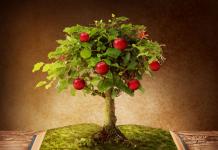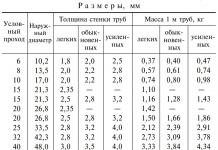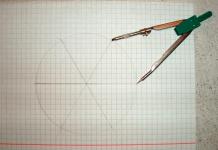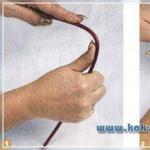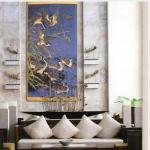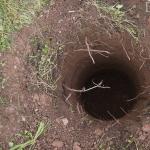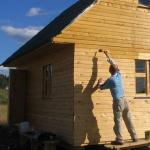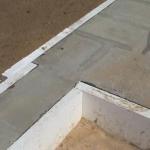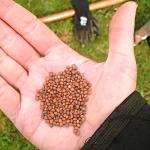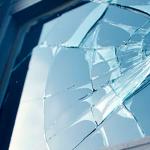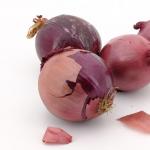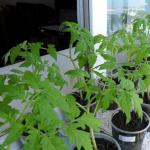I decided to somehow make a couple of rotating stands, like in the photo. Typically these are used for hanging satin ribbons on reels. Height 220 cm, width 50 cm - so the thing is not small.
The stand must be rotating. I had to rack my brains a little. It was necessary to select a pipe, bearing and washer in such a way that together they would form a rotating unit (the design of the rotating unit itself will be presented later). At the beginning I thought that I could simply match them to each other “locally,” but very soon I realized the depravity of this path and went to study literature.
After considering different combinations, I chose the best option:
From "GOST 3262-75. Steel water and gas pipes." I chose a pipe - a “magpie” with an outer diameter of 48.

The frame of the stand is made from a 25x25x1.5 profile pipe. Pipe legs 20x40x2. Crossbars made of 7 mm rod.

From "GOST 7872-89. Single and double thrust ball bearings." I chose 8210 series bearings with an internal diameter of 50.


In "GOST 11371-78. Washers." I found d48 washers with accuracy class A and an internal diameter of 50.

But if there are no problems with the pipe and bearings, then M48 washers of class A accuracy are not a very popular product. Couldn't find any of these for sale.
I found Business Center Leirus LLC on the Internet, located in my city, which listed these washers in the price list on its website. I called the number provided, but their managers are strange. It was not possible to find out what the minimum order is, how many pieces are in a package, what the price is per package and what the delivery time is. I'm not even talking about what accuracy class their washers belong to according to GOST 11371-78.
I solved the problem with the washers simply - I turned to a turner, who turned them for 70 rubles apiece.

Unfortunately, I don't have pipe clamps. But it is important to accurately set the angles and distances between the frame elements. To do this, I cut out a template from plywood with the required dimensions and exact angles and simply fixed the profile pipes on it using clamps.

And there is no frame for the grinder yet either. Therefore, the cutting of parts is not always ideal.

But after welding everything falls into place. I cooked with Monolith 2 mm electrodes. Current 50 A with separation.

Thanks to a simple template, we managed to get good results

We clean the seams with a grinder.

Using the same template, I set up the vertical posts of the frame. It turned out not perfect, but acceptable.

One of the elements of the rotating mechanism is a washer, which is located in the lower part of the frame and which rests on a bearing. It is attached to four sections, which must be welded quite accurately. To do this, we first weld the first crossbar at the bottom of the frame.


Now we weld on the second crossbar

And having made the same cuts, we place the washer in the center

We fix the washer by welding.

At the top of the frame there is another crossbar with a piece of pipe welded perpendicular to it. This piece of pipe will also become an element of the rotating frame in the future.
Part of the future stand is ready. Let's call this part “Rotor”, because this is what will rotate.


Adjustable feet will be welded into the ends of the legs. I drilled the appropriate holes for them.

I made another template from the same plywood. It fixes the position of the legs relative to the bottom edge of the post and the angle of inclination of the legs.

It also fixes the position of the leg relative to the axis of the column.

Using a square, I set the position of the legs relative to each other

After work, the template was slightly charred in the weld areas, but still quite usable.

I welded a washer onto the stator at the bottom. The thrust bearing will rest on this washer, and the rotor washer will rest on it.

At the top of the stand, it was necessary to insert some kind of bushing into the pipe so that the thinner pipe could rotate freely in it. At the same time, I don’t have a lathe either. I had to rack my brains a little more.
As a result, to make the sleeve I took a plastic coupling for 32 mm polyethylene pipes. It fits perfectly into the sorokovka water and gas pipe. The connection is tight, but can be disassembled by hand.

Using a drilling machine, I adjusted the inner diameter of the sleeve. Just in case, to prevent the plastic from melting and damaging the forstner drill, I set the machine to minimum speed - everything went smoothly.

I sawed off the excess parts with a hacksaw and that’s it - the bushing is ready

The rotating mechanism works perfectly - nothing hangs out, does not creak, works smoothly. This can be clearly seen in the video:
Now we need to make it all look presentable. The first step is to remove the rust.

Before painting, protect the adjustable legs and their threads from paint.

And finally, we paint. It was real torture. The fact is that parts of the stands took up all the space in the workshop. They had to be painted in parts and rearranged all the time, because it was impossible to approach them from all sides. As a result, in some places the fresh coating was damaged by an accidental touch, either with an elbow, or with the back, or with something else. The ubiquitous dust also added to the inconvenience.
Therefore, we had to expand the workshop a little and create another room for painting. More about this here:
Now painting work does not cause too many problems and does not take too much time.

Some difficulties arose when painting the crossbars. They are made from 7 mm rod. At the beginning, the strategy was as follows: lay them out on a plane, apply paint with a spray gun, and let them dry. Then turn them over on the other side and apply paint again with a spray gun. The third time, the rods should be painted on all sides. So it was in theory.

But in practice, the bars could not be turned to the other side. Because they are curved and this curvature always tends to take a lower position. Having applied the second layer and seeing that I was painting almost the same side, I decided to paint the rods by hand. Oh, what a tedious job this is! Two coats took almost two full working days.

It was no less tedious to install almost five hundred rod holders, screwing almost a thousand self-tapping screws with a drill into them. By the way, it was not easy to buy them. I had to wander around looking for the required number of identical rod holders.

After installing the rod holders on the frame, we perform the final assembly of the stands. At the bottom, the rotating mechanism consists of two washers separated by a bearing. This unit holds the entire vertical load.

At the top, the rotating mechanism consists of two pipes inserted into one another and separated by a plastic sleeve. This node holds lateral loads.

All that remains is to cut the crossbars

And install them in the rod holders

The rotating stands are almost ready.

One more detail remains. At the top of the stand there is a box, which is put on top and logos are applied to the walls. I decided to make it from 18 mm plywood, although Gamma, which served as a prototype, makes it from tin.

At the top of the box on the inside there is a protrusion with which it is held on the stand frame.

I painted the boxes in my new painter, the link to which is above in this article.
The first layer on wood always looks disgusting - bald spots, raised pile and other joys of a painter.
Therefore, I usually put two layers (and sometimes more) with intermediate sanding of the coating with an abrasive sponge. The first primer layer can be diluted more strongly with a solvent so that it is absorbed deeper into the wood.

The second layer goes on much better

The stands turned out wonderful. In some places even better than the prototype. In general, there is joy from a job well done))

I continue to decorate the class and ran into a problem - I need pockets for pictures, the size is standard. I made several of these pockets from polystyrene foam - it was too long and tedious... then I came across plastic things - a finish for plastic panels... Just right! and now I’ve made several frames from them)) I’ve discovered a lot of positive things - you can use either side, you can even insert a brochure, it’s easier to make... in general, I liked them more than the foam ones. Here I am supplementing the work with a master class.
Ready frame.
Reverse side. I will stick it with double-sided tape, although I think it can be done on “titanium”, then I’ll post a photo of the finished stand))

The film for stitching (it costs 5 rubles per piece) was also glued with double-sided tape, thinner... and secured with regular tape.

frames in action!!

same thing, closer...

and this is the original version - from ceiling tiles

Well, these are ready-made stands)) it looks like it worked out..

I prepared everything I needed. The profile of the finish plastic is clearly visible here.

I applied double-sided tape to the wide side. (cut it into strips, divided the width of the tape into 3 parts)

I cut the short sides at an angle of 45 degrees. And on the reverse side (you can see here) I pasted another piece of tape.

Well, actually, we are assembling the frame)) We need to make sure that the corners are right. If you need to cut something, scissors will help. It's better if the finish is soft - the hard one starts to break... The other side is shown here.

Now we very carefully apply the binding film. If it lies unevenly, then it will be problematic to peel it back off. Although here the width allows you to expand a little in the size of the overlap. I got about 5 mm on one side, and more than a centimeter on the other. Then it won’t be very noticeable.


Well, that’s basically it)) Before gluing it to the surface, it’s better to expand the profile a little from the inside, that is, make sure that the side that will be glued fits tightly to the surface... now this side goes a little inward ..In the first photos you can see that the profile itself is expanded..but here it is a little different, a bit harsh..Well, never mind, we can handle it. It’s better to stick it on Titan, the adhesive tape holds much worse... already passed))
Not sure how best to arrange the portraits and family photos that are so dear to you? Mobile stands will present a private photo gallery in a favorable light.
Framed photo stands not only look beautiful, but have another important advantage: you don't have to hammer a lot of nails into the wall. On a stand made like a staircase, photographs can be rearranged or new ones can be displayed - according to desire and mood. The main trick is that the stands only rest against the wall.
The gallery of family portraits will accommodate all generations, and at any time they can be presented from a different perspective. Funny snapshots of kids and photos of beautiful sunsets taken during vacation will also attract attention.
Making a stand-stand, like everything ingenious, is quite simple. The work steps are shown in the pictures below. The numerous screw-in hinges along the two vertical posts are very important, as they are used to secure the aluminum tubes that serve as supports for the photographs.

Photo stand design sketch
Since the four base bars are also attached with aluminum tubes, they can be easily repositioned. This allows you to combine large and small photos. In addition, the model retains transparency thanks to its elegant tubes. In order for a work of art such as a stand-stand to support the weight of many photographs, it is necessary to secure two MDF plates between the vertical supports for stabilization.
Simple principle. The design is based on adjustable support bars, which are held in place by aluminum tubes. The movement of the ladders is prevented by stoppers that are inserted into pre-drilled holes in the vertical slats.
Making a photo stand
 |
1. To ensure that the holes in the vertical posts and MDF boards run parallel, make marks using a corner. |
 |
2. The holes in the uprights must be very precise. Drill them with a 6mm wood drill bit. |
 |
3. Using glue and 80mm Phillips screws, assemble the board and stand together. |
 |
4. Support strips for photographs are made of two strips (thickness 6 x 2 and 4 x 2 cm), which are glued end to end. Secure them with clamps. |
 |
5. For the screw-in hinges that the aluminum rods slide into, use a 2mm wood drill bit to drill holes in the post strip. When all the parts are assembled, paint the shelf. |
 |
6. After the paint has dried, screw in the hinges for the aluminum rods. |
Fans of unconventional solutions will certainly like photo stands made of perforated MDF panels. Cut panels 260 x 100 cm (sold in stores) according to the required dimensions. To ensure rigidity, a frame made of bars with a cross section of 30 x 19 mm is used; frame - made of aluminum corners.

The overall impression of the gallery depends not only on the selected subjects, but also on the shape of the photo frames and their mounting. Small wooden stands are good because you can even place photos in oval frames on them - they will not turn over.

Perforated panels are unfinished or painted high density white 3mm thick panels with punched holes (usually at 3 or 5cm intervals). With the help of appropriate accessories (hooks or pegs), they are used for convenient and visible storage of the tool. They can also be used as partitions. Since perforated panels are sensitive to impact, their edges must be protected.

Shown here is a perforated panel (rear view) with a frame of slats that gives the structure stability. The position of the fastening hooks depends on the pitch of the holes in the panel.
Making a stand and stands for photographs
 |
1. First, cut rectangular strips (3 x 1.9 cm) to the size of the pegboard (197 x 47.5 cm). |
 |
2. Glue the strips to the back side of the perforated panel and secure with pins. The pins should not be installed far from the edge (maximum 4 mm). |
 |
3. Saw off the aluminum corners (19 x 8 x 1.6 cm) for the edging at an angle and attach them to the perforated panel with mounting adhesive. Use adhesive tape to secure the metal strips until the glue is completely cured. |
 |
4. In the support blocks, drill holes (diameter 1 cm) for a beech wood rod 5 cm long. The drilling template will ensure the accuracy of the drilling. The template must be fixed on the drilling machine table. |
 |
5. Place the round rods on the glue. |
 |
6. To ensure that the mounting hooks are evenly spaced, make a drill template from scraps of pegboard. The photo frame will not move off the rods if you put rubber O-rings with a diameter of 9 mm on them. |
Before cutting aluminum profiles for frames, cover them with masking tape to prevent them from being scratched. Small photo supports made from pine blocks measuring 30 x 13 x 100 mm and round rods are equipped with screw-in hooks and are inserted into a perforated panel. To make them match the aluminum strips, they are painted to look like metal with silver from a can (this kind of paint is used for car wheels). By moving the supports, their position can be easily adjusted to any photo size.
Children are irrepressible dreamers, and their activities can endlessly touch and delight adults. When the results of creativity are in a clearly visible, specially designated place, young fidgets are delighted.
Equipment for an exhibition board does not always involve large financial expenditures. Any interested parent can make children's stands with their own hands.

How to choose the right material
Among the large assortment of modern stands, more and more consumers are choosing cork boards. They are easy to use, reliable, durable, and affordable.

Natural material - cork oak bark - meets general safety requirements for children's products and has a number of positive qualities:
- ecologically pure;
- easy to clean, does not attract dust;
- moisture resistant;
- refractory;
- chemical resistant;
- not damaged by fungus or insects;
- not electrified;
- shockproof;
- wear-resistant.
Cork stands will be a win-win option for both home and kindergarten.

How to make a stand
You don’t need to have any special craft skills or knowledge to please yourself and your children with a functional new item in your home.

Think in advance about how to harmoniously fit your new stand into the interior.

You can experiment both with the color of the board itself - paint it or upholster it with fabric of the desired color, and with the frame, choosing the best combination.
The frame is usually made of wood, plastic, or metal profile. It is also recommended to use cable channels, the width of which is slightly greater than the thickness of the board.

Select the type of wall mount for the stand: permanently glued or free-hanging on hinges.

A minimum set of preparations and tools used, 30 minutes of work - and the result will be on the wall.
Determine the desired dimensions of the stand, prepare a cork sheet to suit the size.

Select the material for the back wall - plywood, fiberboard.

Glue both sheets together. Glue - liquid nails, you can use another one. First degrease the surface, and after applying the glue, press the parts tightly together. If desired, cover the working surface of the stand with fabric.

Attach the previously prepared frame to the base. If desired, attach loops for fastening on the reverse side.

Attach the stand to the wall using glue or double-sided tape for a permanent option. For an alternative method, hang it on loops.
How to use the stand rationally
After you have made the stand with your own hands, you can begin to actively use it.

Note!

There are two main design methods. You can attach pockets to the surface of the board. These can be paper files, or transparent pieces of thin plexiglass, secured with double-sided tape.

This type of design is used for information stands.

The pockets contain sheets of paper with important information that parents should know about the working hours, routine, and rules of behavior for children in kindergarten.

Information can be updated daily (food menu) or as needed.

Stands are actively used by people of different ages both at work and at home. Reminders of important events, planning for the near future, pleasant memories captured in photographs, visualization of your desires, a convenient organizer - everyone will independently add the most relevant for themselves to the list of useful functions.
On demonstration stands made of cork, the necessary items - photographs, pictures, paper notes, small souvenirs - are attached using buttons, pins, tailor's needles.
Note!


The surface of the board does not suffer from this; there are no visible holes left. When setting up a stand for children, you need to make sure that sharp objects cannot harm the kids.

The stand on which teachers display the results of children's work for the day is always popular with concerned parents. And the children are happy to present new crafts and arrange mini-exhibitions in the apartment.

Take a photo of the filled stand as a keepsake, and let it be constantly updated - the world of children's imagination is inexhaustible.

DIY stand photo



Note!






A cork board will be a real find for those who are used to planning things ahead, want to visualize their desires, or simply have a stand to remind them of important events. Notes, pictures, advertisements, and small objects are attached to the accessory. This stand is common in offices, schools, kindergartens, and more and more people are hanging it at home.
What is wall cork board
The material of the accessory is cork oak bark. Cork board is a wooden rectangular sheet of different sizes (often 45x60, 60x90, 100x150, 120x90, 90x120), made from crushed compressed cork and covered with veneer. Notes, posters, information sheets, etc. are attached to the product using buttons or needles. The accessory fits perfectly into almost any interior style.
A cork board on the wall performs different functions. It can be used as standard - for notes and reminders. Household members often paste children’s art and family photographs onto the accessory. It’s easy to make an organizer out of the stand by dividing the surface into squares – the days of the month. If you attach hooks to the bottom of the frame, you can give the item the function of a key holder. Creative owners of the accessory equip one side with small shelves, and leave the other for notes.
Product types:
- Office board. It has a simple appearance - the cork board itself and a strong aluminum profile. It is often produced on a roller stand, which allows the product to be rotated.
- Homemade option. Decorated with various figured frames, shelves, and has a different surface color. If desired, such a wall stand can be covered with fabric or another covering can be made.
Material advantages
The appearance of the cork board itself on the wall is somewhat gloomy, but with proper decor it will sparkle with new colors and will not seem boring. In addition, the tree has the following properties:
- natural material: light, elastic, elastic, environmentally friendly;
- does not allow moisture to pass through and is resistant to high temperatures;
- refractory;
- does not attract dust, does not become electrified;
- resistant to fungi, chemicals, insects;
- he is not afraid of shocks or vibrations;
- after punctures, the resulting holes close almost immediately;
- has a long service life - lasts for several decades.

Features of installation and assembly
Wall notice boards from modern manufacturers have special mounting holes at the corners. An installation kit is almost always sold along with the accessory. If you are making a stand at home, arrange loops on the wrong side. Mounting options:
1.On screws or nails. Drive or screw them into the wall at the required distance, and hang the stand. Do not leave too much of a gap between the wall and the cork sheet at the top so that it does not “move” back and forth when you attach the information material.
2. Liquid nails (glue). In this case, you don’t even have to make holes in the wall. The gluing is done as follows:
- Degrease the surface with any detergent.
- Apply liquid nails pointwise along the perimeter. The distance between the drops is about 5-10 millimeters.
- Press the product firmly against the wall. It will take about 10 minutes for the glue to begin to harden.
3.Good double-sided tape. Cover the perimeter of the wall and place the accessory evenly on the tape.
Where to buy and how much does a wall board for notes cost?

Cork boards for notes are sold in almost any store or hypermarket for home and office. Well-known manufacturers (Attache, TCO, IKEA, Komus) provide high quality products. You can also place an order from small manufacturers who offer the sheets themselves. Ready-made cork boards for the wall have different prices. The price of a 45x60 sample from Attache with a wooden frame is 750 rubles, with an increase in area and improved characteristics, the cost increases to 2000-5000 rubles. A cork oak sheet is cheaper, but it is sold without a frame.
How to make a cork stand with your own hands
It is more profitable to make a cork board on the wall yourself. It will not cost too much and will fit organically into the room you need, since you will create your own design. How to make a cork board with your own hands:
- Buy a cork sheet of the size you need.
- You will need another piece of hardboard of the same area. It will serve as the back surface of the stand. Glue the hardboard.
- You can decorate the sheet or cover it with fabric.
- Decide on a frame. Common materials are aluminum, plastic, wood. It is convenient to take cable channels slightly wider than the thickness of the board.
- Cut the corners of the frame at 45º. Attach the frame to the base.
- If you mount the product with screws, provide loops for them. The use of glue or double-sided tape does not require additional manipulations.


